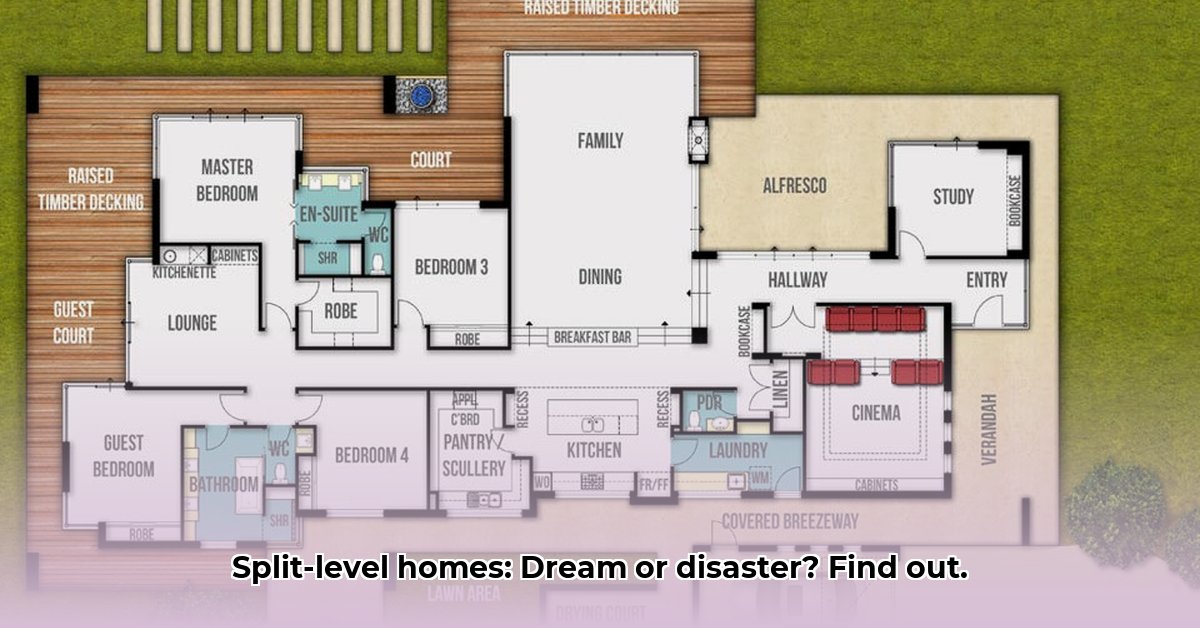Are you drawn to the unique appeal of split-level homes? These designs offer creative spatial solutions and well-defined living spaces. This comprehensive guide explores split-level designs, covering their evolution, advantages, essential design principles, and exciting renovation possibilities. Whether you’re considering buying, building, or undertaking a remodel, this resource will equip you with the insights needed to make informed decisions and craft a split-level home perfectly tailored to your lifestyle. For more on different floor plan types, check out this helpful resource on floor plan types.
Exploring Split-Level Homes: A Guide to Multi-Level Living
Split-level homes present a distinctive combination of space efficiency and clearly defined zones, evolving from the classic ranch-style design. Is this layout the ideal choice for your family, considering aspects like accessibility and upkeep? Let’s delve into the world of multi-level living and discover what makes split-level homes so unique.
Understanding the Layout: The Art of Separated Yet Connected Living
Split-level homes are characterized by their strategic arrangement of living spaces across multiple levels, interconnected by short sets of stairs. The main level typically acts as the home’s central hub, housing the living room, kitchen, and dining area, ideal for fostering family interaction.
The upper level often accommodates the bedrooms, creating a private retreat, while the lower level may feature a family room, a dedicated home office, or a comfortable guest suite. This layout optimizes space utilization on smaller lots, a common feature in urban and suburban settings, thereby enhancing both functionality and privacy. This layered approach cleverly maximizes space, offering a versatile solution in various environments.
Weighing the Pros and Cons: Is a Split-Level Home Right for You?
Like any architectural style, split-level homes come with their own set of advantages and disadvantages. Understanding these can help you determine if this type of home is the right fit for your unique lifestyle. Will the distinct zones offered by a split-level enhance your daily life, or will the staircases present long-term challenges?
| Pros | Cons |
|---|---|
| Efficient use of space, especially on smaller lots | Potential for limited natural light on lower levels |
| Well-defined zones for various activities | Staircases can be challenging for elderly individuals or those with mobility concerns |
| Potential for additional living space or flexible customization | Can feel more compartmentalized compared to open-concept homes |
| Often more budget-friendly to build compared to larger two-story homes | Climate control can be less efficient across multiple levels without proper zoning |
| Opportunity for daylight basements, enhancing natural light and space | Resale value can fluctuate based on location, market trends, and the home’s specific features |
- Efficient Space Use: Maximize living area on compact properties.
- Distinct Zones: Enjoy clearly separated areas for work, relaxation, and family time.
- Potential Cost Savings: Benefit from potentially lower construction costs.
Exploring the History: The Rise of the Split-Level Home
Split-level homes gained significant traction in the mid-20th century, coinciding with the post-World War II suburban expansion. They presented an affordable and space-efficient housing option suitable for growing families. The separation of spaces appealed to many, providing dedicated zones for both children and adults, fostering a balance of privacy and togetherness. Did the appeal of distinct living zones contribute to the widespread popularity of split-level homes during this transformative era?
Modern Split-Level Homes: A Design That Stands the Test of Time
While the fundamental concept remains consistent, contemporary split-level designs have evolved far beyond their mid-century origins. Architects and builders are creating impressive variations, from sleek, modern designs to charming rustic farmhouse styles. The possibilities are virtually limitless, allowing you to tailor your home to reflect your personal tastes and accommodate your lifestyle. Through design innovation, have split-level homes successfully adapted to meet the ever-changing preferences of today’s homeowners?
Finding Your Perfect Split-Level: Key Considerations
Before committing to a split-level home, carefully consider these crucial factors:
- Your Lifestyle: Does your lifestyle benefit from having distinct areas for work, relaxation, and entertainment, or do you prefer open, flowing spaces?
- Your Family’s Needs: Assess the accessibility requirements of all family members, paying close attention to the presence of staircases.
- Your Budget: Factor in both the initial costs of purchasing or building, as well as long-term expenses such as heating, cooling, and potential maintenance.
Designing Your Dream Split-Level: Practical Tips
Keep the following tips in mind to maximize the potential of your split-level home:
- Maximize Natural Light: Strategically position windows and skylights to brighten lower levels and create a more inviting atmosphere throughout the home.
- Embrace Open-Concept Elements: Incorporate open railings and connecting spaces to enhance visual flow between levels and create a sense of spaciousness.
- Smart Space Planning: Optimize the layout of each level to effectively meet the specific needs of your family, ensuring functionality and comfort in every area.
- Consider Vertical Design: Utilize vertical space with shelving, artwork, and tall windows to draw the eye upwards and emphasize the home’s unique structure.
The Enduring Appeal: The Future of Split-Level Homes
Although market trends are subject to change, the inherent efficiency and adaptability of split-level homes suggest their continued relevance in the housing landscape. Their versatility, paired with innovative design solutions, ensures that this classic style will continue to evolve and meet the needs of modern families for generations to come. By retaining core functionality while embracing modern living expectations, can the split-level design effectively adapt to the evolving needs of future homeowners?
Optimizing Energy Efficiency in Your Split-Level Home
Due to their unique staggered floor plans, split-level homes often present specific energy efficiency challenges. However, by implementing strategic upgrades, you can reduce energy bills by as much as 25%, all the while creating a more comfortable and sustainable living environment.
Key Takeaways:
- Split-level homes present distinct energy efficiency challenges due to their design.
- Implementing well-planned renovations can significantly lower energy consumption and reduce utility costs, potentially by up to 25%.
- Prioritizing upgrades to insulation, windows, and doors can have a substantial and immediate impact on energy savings.
Understanding the Energy Challenges of Split-Level Homes
The staggered floor plans of split-level homes present unique challenges to maintaining energy efficiency. The increased surface area exposed to the elements can lead to greater heat loss during the winter months and heat gain during the summer. In older homes, these issues may be further compounded by outdated insulation and inefficient windows and doors. Is the energy performance of a split-level home significantly impacted by the age and condition of its insulation and windows?
Prioritizing Key Energy-Saving Upgrades
To effectively improve energy efficiency, prioritize the following steps:
- Insulation is Paramount: Conduct a thorough assessment of your current insulation levels and consider adding blown-in insulation to attics and crawl spaces to significantly improve thermal resistance. Investing in proper insulation is similar to wrapping your home in a warm, protective blanket.
- Window and Door Enhancements: Replace older, less efficient windows with energy-efficient double- or triple-pane models. Additionally, carefully seal any gaps or cracks around doors and windows to prevent unwanted air leaks.
- HVAC System Optimization: Consider implementing a zoned HVAC (Heating, Ventilation, and Air Conditioning) system to maintain consistent and comfortable temperatures across the various levels of your home, while also minimizing energy waste.
- Smart Home Integration: Incorporate smart thermostats and energy-monitoring power strips to gain valuable insights into your energy consumption patterns and enable long-term savings through optimized control.
- Air Sealing Techniques: Seal any cracks, gaps, or penetrations around windows, doors, and utility access points to maintain stable and consistent temperatures throughout your home.
Budgeting for Energy Efficiency Renovations
Undertaking energy-efficient renovations requires a carefully planned budget. Project costs can vary considerably depending on the size of your home and the specific materials you select. It’s essential to plan for expenses across multiple phases of the project and to consider the long-term energy savings that will result from your investment. This financial strategy is crucial in how to improve energy efficiency in a split level home. What financial strategies can homeowners use to effectively manage the costs associated with energy efficiency upgrades in split-level homes?
Maximizing Your Return on Investment
Improving energy efficiency not only helps to reduce your environmental impact but also creates a more comfortable and sustainable home. By strategically focusing on insulation, window and door upgrades, HVAC optimization, and comprehensive air sealing, you can transform your split-level into a true energy-efficient haven.
Fact: Energy-efficient renovations can significantly reduce your energy bills, potentially saving you up to 25%.
Designing Energy-Efficient Split-Level Homes for Cold Climates
In cold climates, achieving energy-efficient design requires a comprehensive and integrated approach that encompasses the building envelope, HVAC systems, and appliance efficiency. By significantly improving the home’s thermal performance, you can potentially achieve energy savings in the range of 30-50%.
Key Takeaways:
- Significant energy savings are achievable in cold climates through careful design and construction practices, with potential reductions of 30-50%.
- Effective insulation and comprehensive air sealing are crucial for minimizing heat loss
- Gray Kitchen Backsplash Ideas: Find Your Perfect Gray Tile - December 11, 2025
- Glass Wall Tiles For Bathroom: A Stylish, Durable Choice - December 10, 2025
- Glass Mosaic Kitchen Backsplash: Add Shimmer and Style - December 9, 2025









